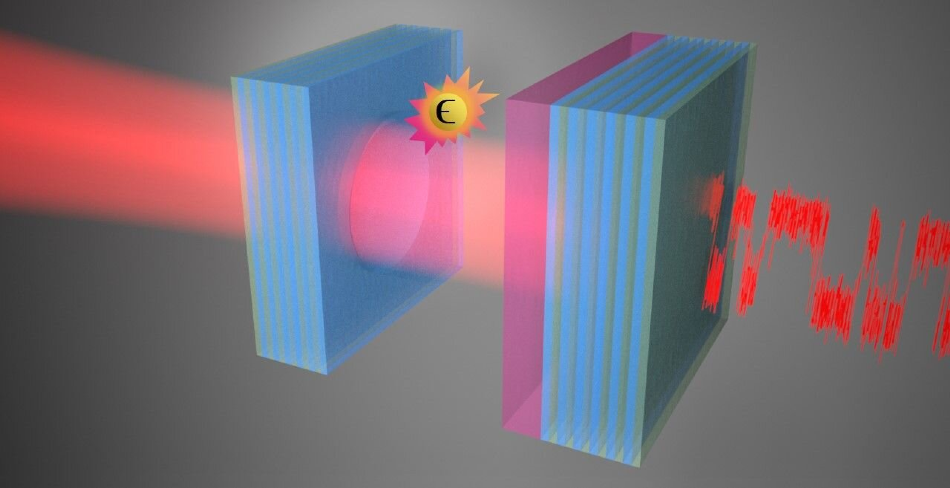 An optical cavity with a nonlinear material (purple) between two mirrors (blue). Light that enters from the left, resonates inside the cavity. Due to noise, the output on the right switches randomly between two values. A small perturbation in the cavity (like a particle, shown here as the yellow Є) changes the switching output pattern. Credit: Rodriguez and Boluijt, AMOLF
An optical cavity with a nonlinear material (purple) between two mirrors (blue). Light that enters from the left, resonates inside the cavity. Due to noise, the output on the right switches randomly between two values. A small perturbation in the cavity (like a particle, shown here as the yellow Є) changes the switching output pattern. Credit: Rodriguez and Boluijt, AMOLF
Typically, any noise that runs through an electrical signal can disturb and disrupt conventional optical sensing techniques. However, Said Rodriguez, a physicist from AMOLF research institute in the Netherlands, has developed a method that uses noise as a resource to enhance the speed and sensitivity in nonlinear optical sensors.
This method is not the usual way of thinking through the issue of regulating noise in optical sensing systems. This is due to the fact these sensing systems are often required to detect the changes and disturbances in their surroundings that can often register around the same frequency as the problematic and residual noise patterns. “Using noise to improve sensing methods is counterintuitive,” stated Rodriguez, who recently published his study in the journal Physical Review Applied.
Noise Enhancing Detection
Detecting minute fluctuations in the environment is a crucial function of optical sensors and even if the removal of all “classical (e.g. thermal)” noise has been successful, residual “quantum noise” remains, according to Rodriguez. Thus, as changes in the resonance frequency are detected due to a variation in the light concentration the residual noise can still negatively impact the measurement, especially in linear sensors.
Therefore, Rodriguez advocates for the use of nonlinear optical sensors in order to utilize noise as a resource for better optical detection.
Inside the optical cavity, we add a material that influences the resonating light in a non-linear way. The light that comes out is not a linear function of what went in, but it is bistable: for a given input, the output has two possible values.
Dr. Said Rodriguez, Physicist, AMOLF Research Institute
What happens next is that any noise detected in the system causes the, “output of the sensor to flip randomly between the two values.” Thus, when the smallest of changes or tiny variance occurs in the resonance frequency due to a photon particle entering the optical cavity the “flipping pattern” also changes.
Once careful analysis of the measurements and data has been conducted, any changes or perturbations in resonance frequency are revealed. This is because the signal of the nonlinear sensor scales “exponentially” with the strength of the changes. This contrasts heavily with linear sensing methods usually scales linearly with the changes.
Moreover, since the noise presence affects the flipping rate between values and increased noise can lead to an increase in the flipping rate, noise enhances the detection speed of the sensor. Rodriguez states, “In conventional sensors increased noise increases the time needed to detect something entering the cavity, but in this sensor the detection is faster when there is more noise. That is really remarkable.”
The Quantum Issue
As quantum noise is practically an unavoidable issue, developing sensors that can appropriate the noise is an inventive strategy for accurate sensing systems. Another key insight that Rodriguez came across when conducting his research was that the increases in the noise did not only have a positive impact on the speed but also the sensitivity of the nonlinear sensors.
“Just like the detection speed, the sensitivity increases with noise, but not continuously. It turns out that this sensor can perform optimally in the regime of quantum noise,” said Rodriguez. “This makes it an interesting alternative in regimes where conventional sensors cannot perform very well.”
A New Chapter
Throughout his research, Rodriguez made numerous calculations and comparisons between nonlinear and linear sensing systems and found a close correlation in performance between the two. The next step is to further research and develop the system with sights set on creating a physical and operational sensor that optimizes environmental and quantum noise.
Rodriguez states that by illustrating how the, “inevitable quantum noise can be embraced for sensing, these results may push the limits of what is detectable by state-of-the-art optical sensors." This could be the start of a new chapter for where applications of “ultrafast” nonlinear optical sensors are concerned. Rodriguez’s proposals could come to enhance the detection of nanoparticles, biological entities and contaminants that influence the resonance frequency of such sensors.
Disclaimer: The views expressed here are those of the author expressed in their private capacity and do not necessarily represent the views of AZoM.com Limited T/A AZoNetwork the owner and operator of this website. This disclaimer forms part of the Terms and conditions of use of this website.